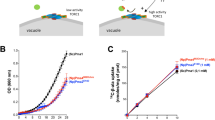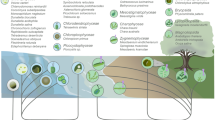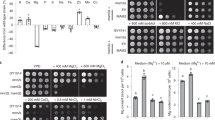Abstract
The plasma membrane ATPase of plants and fungi is a hydrogen ion pump1. The proton gradient generated by the enzyme drives the active transport of nutrients by H+-symport. In addition, the external acidification in plants and the internal alkalinization in fungi, both resulting from activation of the H+ pump, have been proposed to mediate growth responses. This ATPase has a relative molecular mass (Mr) similar to those of the Na+-, K+- and Ca2+-ATPases of animal cells and, like these proteins, forms an aspartylphosphate intermediate. We have cloned, mapped and sequenced the gene encoding the yeast plasma membrane ATPase (PMA1) and report here that it maps to chromosome VII adjacent to LEU1. The strong homology between the ammo-acid sequence encoded by PMA1 and those of (Na+ + K+), Na+-, K+- and Ca2+-ATPases is consistent with the notion that the family of cation pumps which form a phosphorylated intermediate evolved from a common ancestral ATPase. The function of the PMA1 gene is essential because a null mutation is lethal in haploid cells.
This is a preview of subscription content, access via your institution
Access options
Subscribe to this journal
Receive 51 print issues and online access
$199.00 per year
only $3.90 per issue
Buy this article
- Purchase on Springer Link
- Instant access to full article PDF
Prices may be subject to local taxes which are calculated during checkout
Similar content being viewed by others
References
Serrano, R. Curr. Topics cell. Regul. 23, 87–126 (1984).
Young, R. A. & Davis, R. W. in Genetic Engineering: Principles and Methods Vol. 7 (eds Setlow, J. K. & Hollaender, A.) 29–41 (Plenum, New York, 1985).
Melpartida, F. & Serrano, R. Eur. J. Biochem. 116, 413–417 (1981).
Mihara, K. & Blobel, G. Proc. natn. Acad. Sci. U.S.A. 77, 4160–4164 (1980).
Drescher, D. G. & Lee, K. S. Analyt. Biochem. 84, 559–569 (1978).
Thomas, R. E., Korzeniowski, D., Ryan, D. & Levin, W. Archs Biochem. Biophys. 192, 524–532 (1979).
Burnette, W. N. Analyt. Biochem. 112, 195–203 (1981).
Rott, R. & Nelson, N. J. biol. Chem. 256, 9224–9228 (1981).
Huynh, T. V., Young, R. A. & Davis, R. W. in DNA Cloning Techniques: A Practical Approach (ed. Glover, D.) (IRL, Oxford, in the press).
Norrander, J., Kempe, T. & Messing, J. Gene 26, 101–106 (1983).
Pikielny, G. W., Teem, J. L. & Rosbash, M. Cell 34, 395–403 (1983).
Hesse, J. E. et al. Proc. natn. Acad. Sci. U.S.A. 81, 4746–4750 (1984).
Shull, G. E., Schwartz, A. & Lingrel, J. B. Nature 316, 691–695 (1985).
MacLennan, D. H., Brandl, C., Korczak, B., & Green, N. M. Nature 316, 696–700 (1985).
Walderhaug, M. O., Post, R. L., Saccomani, G., Leonard, R. T. & Briskin, D. P. J. biol. Chem. 260, 3852–3859 (1985).
Farley, R. A. & Faller, L. D. J. biol. Chem. 260, 3899–3901 (1985).
Dame, J. B. & Scarborough, G. A. J. biol. Chem. 256, 10727–10730 (1981).
Berry, E. A. & Hinkle, P. C. J. biol. Chem. 258, 1474–1486 (1983).
Ovchinnikov, Y. A., Abdulaev, N. G. & Modyanov, N. N. A. Rev. Biophys. Bioengng 11, 445–463 (1982).
Schwartz, D. C. & Cantor, C. R. Cell 37, 67–75 (1984).
Carle, G. F. & Olson, M. V. Nucleic Acids Res. 12, 5647–5664 (1984).
Hsu, Y. P. & Schimmel, P. J. biol. Chem. 259, 3714–3719 (1984).
Downie, J. A., Gibson, F. & Cox, G. B. A. Rev. Biochem. 48, 103–131 (1979).
Orr-Weaver, T. L., Szostak, J. W. & Rothstein, R. J. Proc. natn. Acad. Sci. U.S.A. 78, 6354–6358 (1981).
Maxam, A. M. & Gilbert, W. Meth. Enzym. 65, 499–560 (1980).
Bencini, D. A., O'Donovan, G. A. & Wild, J. R. Biotechniques 2, 1–70 (1984).
Heffron, F., So, M. & McCarthy, B. J. Proc. natn. Acad. Sci. U.S.A. 75, 6012–6016 (1978).
Staden, R. Nucleic Acids Res. 10, 2951–2961 (1982).
Kyte, J. & Doolittle, R. F. J. molec. Biol. 157, 105–132 (1982).
Eisenberg, D. A. Rev. Biochem. 53, 595–623 (1984).
Serrano, R. FEBS Lett. 156, 11–14 (1983).
Author information
Authors and Affiliations
Rights and permissions
About this article
Cite this article
Serrano, R., Kielland-Brandt, M. & Fink, G. Yeast plasma membrane ATPase is essential for growth and has homology with (Na+ + K+), K+- and Ca2+-ATPases. Nature 319, 689–693 (1986). https://doi.org/10.1038/319689a0
Received:
Accepted:
Issue Date:
DOI: https://doi.org/10.1038/319689a0
This article is cited by
Adaptive responses of yeast strains tolerant to acidic pH, acetate, and supraoptimal temperature
Applied Microbiology and Biotechnology (2023)
The plasma membrane H+-ATPase is critical for cell growth and pathogenicity in Penicillium digitatum
Applied Microbiology and Biotechnology (2022)
Voltage-gated proton channels from fungi highlight role of peripheral regions in channel activation
Communications Biology (2021)
Structure and activation mechanism of the hexameric plasma membrane H+-ATPase
Nature Communications (2021)
Purification and initial characterization of Plasmodium falciparum K+ channels, PfKch1 and PfKch2 produced in Saccharomyces cerevisiae
Microbial Cell Factories (2020)
Comments
By submitting a comment you agree to abide by our Terms and Community Guidelines. If you find something abusive or that does not comply with our terms or guidelines please flag it as inappropriate.



